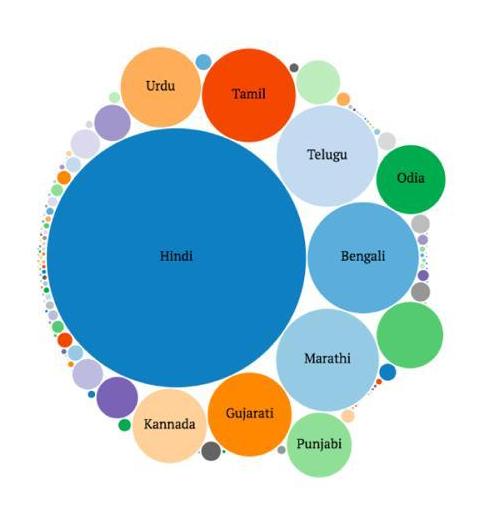Editor’s note – In this post, Kanu Garg, writes about the Supreme Court of India’s recent initiative to make its judgments available in 7 regional languages. While recognizing the need for such a move, Kanu writes about why we must not pat ourselves on the back yet. As she points out, verbose and lengthy judgments, complex language and obscure references still undermine access to justice.
Recently, the Supreme Court started making its judgments available on this link in seven Indian languages: Kannada, Telegu, Marathi, Odia, Assamese, Tamil and Hindi. The Court plans to gradually expand the initiative to other languages as well. The translations are available on the Court’s official website a week after the order is uploaded in English.
This move is clearly indicative of a movement in the Indian legal system so as to improving “access to justice” for all. The idea is to make litigation more conducive and less alien for the litigants. This is exemplified in the speech made by President Ram Nath Kovind in a conference in Kochi about two years ago, which is believed to be the inspiration behind this initiative. In this speech, he said that it is not enough that people are given justice, but it must also be made understandable for them. As the same has not been achieved yet, litigants are forced to depend on lawyers to translate the order and judgment for them.
While the initiative by the Supreme Court is a step ahead in this direction, it alone might not be enough to reach the ultimate goal of access to justice, as the language of Supreme Court judgments is not the only barrier that exists. It first needs to deal with far bigger demons. At a primary level, these include the torturous wording of judgments and their mammoth length. At a broader level, these are the language barriers that pervade much deeper into the legal system. The following sections examine some of these demons that stand in the way of making access to justice a reality.
The biggest roadblock to Supreme Court’s noble initiative – the judges (authors) themselves
In April 2017, a 2-judge bench of the Supreme Court was compelled to set aside an order by the High Court of Himachal Pradesh because the ridiculously complex English used by the Hon’ble lordships rendered it incomprehensible, not only for the litigants involved in the dispute but also for the Supreme Court judges and lawyers engaged at the appellate level process. However, the use of complicated language is not limited to High Court judges. I would say that the former Supreme Court Justice V.R. Krishna Iyer was (in)famous for his excessive literary references and heavy vocabulary. More recently, former Chief Justice of India Dipak Misra faced serious flak for similar reasons. The very openings of his judgments throw readers off balance. Here is an oft quoted passage from Subramaniam Swamy v. Union of India to illustrate –
“This batch of writ petitions preferred under Article 32 of the Constitution of India exposits cavil in its quintessential conceptuality and percipient discord between the venerated and exalted right of freedom of speech and expression of an individual…”
Notably, for not-so-cavil expositions on Justice Misra’s judgment-writing, one may refer to Tunku Varadarajan’s article that appeared on The Wire that he amusedly titled as “Judgment by Thesaurus“.
Legal jargon, double negation, absurdly long sentences (sometimes as long as 192 words) and redundant phrases abound apex court’s judgments. Use of impersonal construction and unusual sentence structure renders these judgments incomprehensible even for those with a decent understanding of English. Since these aspects of judgments cannot be resolved in verbatim translations, their incomprehensibility will only get carried forward into other languages. In all probability, these translated judgments will continue to still remain out of bounds for common people despite the translation, who will again have to rely on lawyers or linguists to break down the judgment for them – precisely the intermediate set up that the Supreme Court set out to eliminate in the first place through this initiative.
The troubles caused by tortuous (and even torturous) wording of judgments and orders are further compounded by the daunting length of these judgments. In general, courts are known to render unnecessarily verbose judgments and very often the finer points of importance get lost in these colossal bundles of papers. For instance, the judgment in Joseph Shine v. Union of India was a staggering 150 pages long text, while Navtej Johar v. Union of India closely surpassed its double, at 310 pages. Verbatim translations will inevitably be just as long and labyrinthine as the original ones. This problem will persist until judges continue to render painfully long judgments.
One reason attributed to these features of Indian judgments is that judges seem to believe that high-sounding language, literary references and lengthy judgments are symbolic of intellectual supremacy ultimately adding value to judicial analysis and exposition. Quite to the contrary, these practices render the judgments way outside the scope of understanding of common masses, who then fail to appreciate not only the intellectual undercurrents but also the operative holding of these judgments. If only judges made their verdicts more understandable for the common public, their reasoning and opinions would garner praise from more corners than just the closed confines of the legal fraternity.
The noble objective of the Supreme Court to make judgments accessible to more and more people cannot be met only by translating judgments into other languages. Apart from the fact that translating phrases like “quintessential conceptuality” and “percipient discord” is not going to be a piece of cake, these efforts might not even bear fruit unless they are coupled with a commitment on the part of the judges to make their judgments comprehensible for the litigants.
There is more to access to justice than comprehensibility of Supreme Court judgments
If the idea really is to minimize the role of lawyers in the legal system and to give people greater control over what happens in their own disputes, the Supreme Court’s initiative alone cannot bear the desired results unless coupled with other, more radical reforms.
To begin with, the language barrier in the accessibility of judiciary is far bigger a problem at the stage of hearing than that of judgment. Article 348 of the Indian Constitution provides that all proceedings in the Supreme Court and the High Courts must be conducted in English. This means that courtroom discussions and arguments remain a prerogative of expensive English-speaking advocates and are out of bounds for even the litigants whose disputes are the point of discussion. However, under Article 348(2), Governors with the assent of the President can allow the use of local languages in High Courts. Thus, one possible reform is extending the idea of translation and linguistic accessibility to the stage of hearing. If not the Supreme Court, at least the High Courts and lower courts should hold proceedings in local languages.
Even the translation of judgments is probably far more vital in the lower courts and High Courts than in the Supreme Court as translated copies of the order can help litigants make an informed decision as to their future course of action (whether or not to appeal) in the matter. In my opinion, the Supreme Court being the court of final appeal and last resort, where most matters are finally put to rest, the need for translated copies of the judgment is relatively lesser.
Increased involvement and participation of the litigants at every stage of the litigation is the ideal if we intend to make complete “access to justice” a reality. But there is still a long way to go before we can achieve this goal. The efforts made by Chief Justice Ranjan Gogoi are one step in that direction amongst many more that would hopefully follow.
Kanu Garg is a Writing Fellow for Nyaya’s NALSAR Legal Practice Hub and her interests include Constitutional law and Human Rights law, particularly the rights of women and children.







Leave A Comment